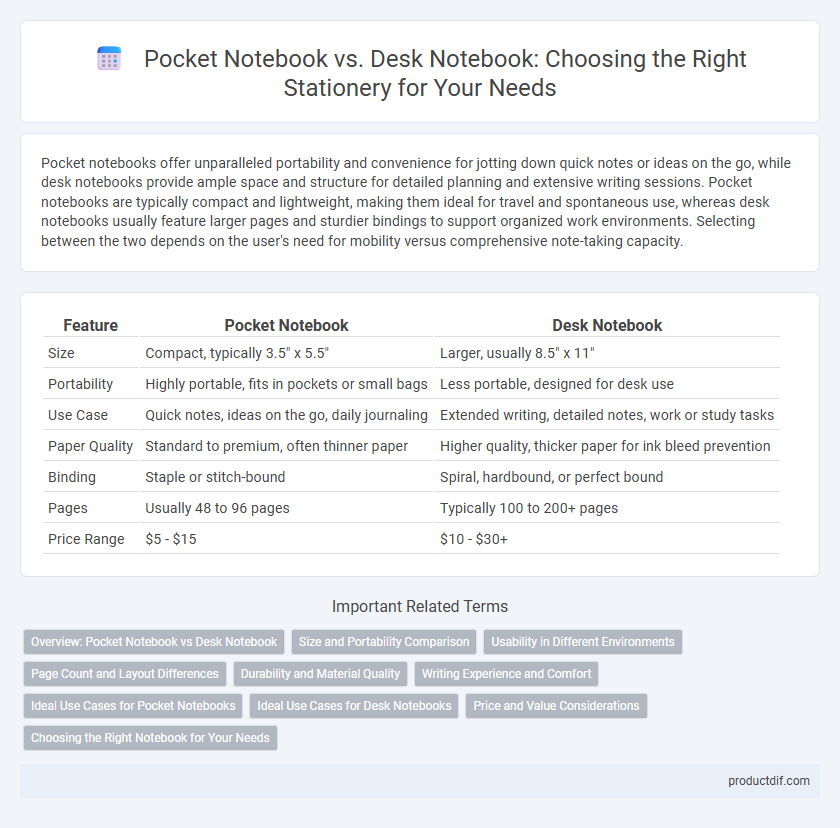Pocket notebooks offer unparalleled portability and convenience for jotting down quick notes or ideas on the go, while desk notebooks provide ample space and structure for detailed planning and extensive writing sessions. Pocket notebooks are typically compact and lightweight, making them ideal for travel and spontaneous use, whereas desk notebooks usually feature larger pages and sturdier bindings to support organized work environments. Selecting between the two depends on the user's need for mobility versus comprehensive note-taking capacity.
Table of Comparison
| Feature | Pocket Notebook | Desk Notebook |
|---|---|---|
| Size | Compact, typically 3.5" x 5.5" | Larger, usually 8.5" x 11" |
| Portability | Highly portable, fits in pockets or small bags | Less portable, designed for desk use |
| Use Case | Quick notes, ideas on the go, daily journaling | Extended writing, detailed notes, work or study tasks |
| Paper Quality | Standard to premium, often thinner paper | Higher quality, thicker paper for ink bleed prevention |
| Binding | Staple or stitch-bound | Spiral, hardbound, or perfect bound |
| Pages | Usually 48 to 96 pages | Typically 100 to 200+ pages |
| Price Range | $5 - $15 | $10 - $30+ |
Overview: Pocket Notebook vs Desk Notebook
Pocket notebooks offer compact portability ideal for quick notes and on-the-go jotting, measuring typically around 3.5 x 5.5 inches. Desk notebooks provide larger pages, often 8.5 x 11 inches or A4 size, suited for detailed work, brainstorming, and extensive writing sessions. Choosing between them depends on mobility needs versus space requirements for writing and organizing information.
Size and Portability Comparison
Pocket notebooks typically measure around 3.5 x 5.5 inches, making them compact and highly portable for on-the-go note-taking. Desk notebooks usually range from 8.5 x 11 inches to A4 size, offering ample writing space but less convenience for carrying around. The smaller size of pocket notebooks enhances mobility, while desk notebooks provide a stable surface better suited for detailed work and longer writing sessions.
Usability in Different Environments
Pocket notebooks offer unmatched portability, making them ideal for capturing ideas on the go in outdoor or mobile environments. Desk notebooks provide larger writing surfaces and enhanced durability, suited for detailed note-taking and extended sessions in office or home settings. Choosing between them depends on the need for convenience during travel versus comprehensive usability in a stationary workspace.
Page Count and Layout Differences
Pocket notebooks typically feature fewer pages, usually ranging from 40 to 80, designed for portability and quick note-taking on the go. Desk notebooks often contain 100 to 200 pages, offering more space for detailed notes, brainstorming, or project planning. Layouts in pocket notebooks favor simplicity with lined or dotted pages for versatility, while desk notebooks commonly include a variety of page styles such as grids, margins, or blank pages to accommodate diverse write-ups and sketches.
Durability and Material Quality
Pocket notebooks often feature durable covers made from synthetic materials or coated paper, designed to withstand frequent handling and exposure to various elements, making them ideal for on-the-go use. Desk notebooks typically utilize higher-quality paper and sturdier bindings such as thread-sewn or hardbound covers, enhancing longevity and providing a premium feel during extensive desk work. The choice of materials directly affects durability: pocket notebooks prioritize portability with water-resistant surfaces, while desk notebooks emphasize robustness and paper quality for long-term archival purposes.
Writing Experience and Comfort
Pocket notebooks offer portability and convenience, making them ideal for quick notes and on-the-go sketches, but their smaller size can limit writing space and comfort during extended use. Desk notebooks provide larger pages and a stable surface, enhancing writing comfort and allowing for more detailed notes or creative work. Choosing between the two depends on the balance of mobility versus comfort preferred by the user.
Ideal Use Cases for Pocket Notebooks
Pocket notebooks excel in portability and convenience, making them ideal for on-the-go note-taking, quick sketches, or jotting down ideas during meetings or travel. Their compact size fits easily into pockets or small bags, perfect for capturing spontaneous thoughts without the bulk of a desk notebook. Designed for mobility, pocket notebooks serve professionals, students, and creatives who require a lightweight, durable option for immediate access to notes.
Ideal Use Cases for Desk Notebooks
Desk notebooks are ideal for detailed note-taking, brainstorming, and project planning due to their larger size and ample writing space. Their sturdy construction and wide pages accommodate sketches, diagrams, and extensive annotations, making them perfect for office or study environments. Unlike pocket notebooks, desk notebooks support prolonged use without compromising legibility or organization.
Price and Value Considerations
Pocket notebooks typically offer a lower price point due to their compact size and limited pages, making them an economical choice for on-the-go note-taking. Desk notebooks generally provide greater value with more extensive page counts and larger writing surfaces, ideal for detailed notes and professional use. Evaluating price and value depends on individual needs: pocket notebooks maximize portability and affordability, whereas desk notebooks emphasize comprehensive usability and durability.
Choosing the Right Notebook for Your Needs
Pocket notebooks offer portability and convenience, ideal for quick note-taking on the go, while desk notebooks provide larger pages and more space for detailed writing or sketches, suited for office or home use. Choosing the right notebook depends on your primary needs: if mobility and compactness are crucial, a pocket notebook is the optimal choice; for extensive note-taking and organizing information, a desk notebook enhances productivity. Consider factors like paper quality, binding type, and page layout to match your writing style and task requirements.
Pocket notebook vs Desk notebook Infographic

 productdif.com
productdif.com